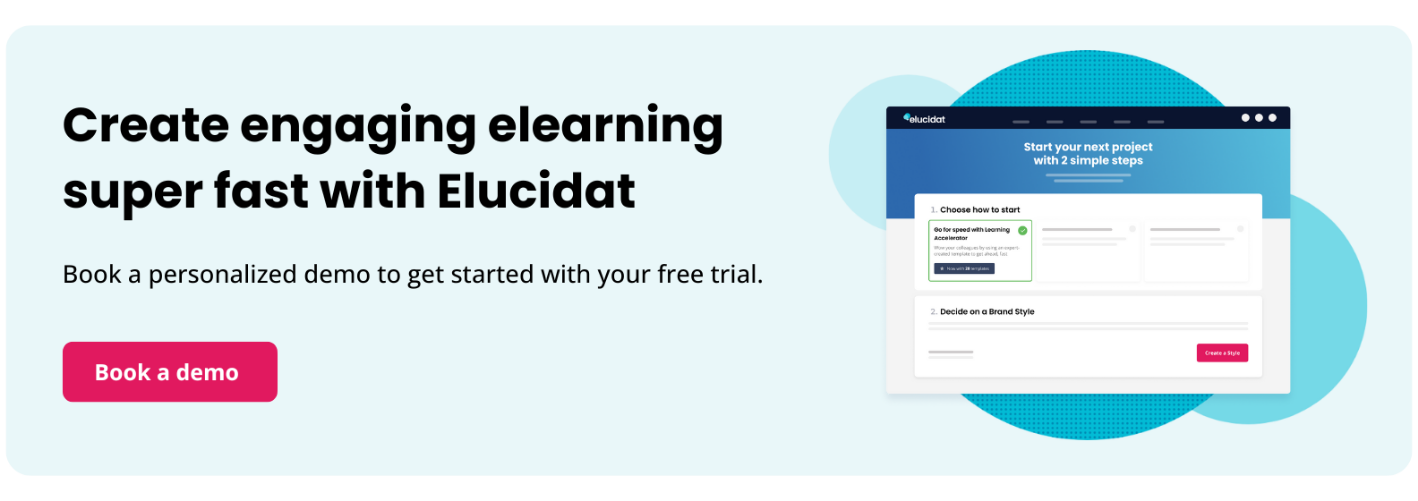How to boost elearning engagement with compelling content
12 minute read
With most learners rating their organization’s online training as fair to poor, elearning engagement has become the elephant in the room in discussions about improving completion rates in elearning courses. Don’t leave your learners in the lurch. It’s time to create elearning that hooks your audience, nails your learning goals, and leaves them hungry for more. Read on to find out how.

What is elearning engagement?
Think back to your school days. Was there a class that truly sparked your interest? Odds are, you were actively involved and eager to participate, which is a goal in instructional strategies to increase engagement. You were motivated – maybe even inspired.
In other words, you were an engaged learner.
Elearning engagement isn’t any different. It refers to the degree of attention, curiosity, interest, optimism, and enthusiasm that learners show when they’re learning online.
But all this can be tricky to achieve. Without the social element of the classroom, learner attention can easily drift.
What does learner engagement look like?
Engaged learners are those who are willing to keep interacting with content to achieve a learning outcome.
Here’s what you can expect from engaged learners:
- Active participation in elearning activities.
- Great results on knowledge checks and tests.
- Positive feedback about online content.
Most importantly, they come away from online learning having learned – well – exactly what you wanted them to learn.
And they put that learning into practice afterwards too.
Why is elearning engagement important?
The numbers speak for themselves. 63% of L&D professionals say that content issues are reducing the impact of their online classes. A lack of learner engagement is a huge problem.
Learners are saying the same thing. 60% of employees in large organizations rate their elearning as fair to poor.
The result? Bored learners rushing through content, trading assessment answers to check elearning off their to-do list.
Hardly a recipe for success.
Improve engagement, though, and here’s what you’ll see:
- Motivated learners who are switched on, interested, and eager for more are often the result of well-designed training programs.
- Great learning outcomes that justify learners’ time and the resources spent on design.
- Measurable results in terms of improved skills and employee performance.
Ready to make this happen? Read on to discover how to increase engagement in online learning.
New to elearning engagement or elearning creation? Here’s a good place if you are looking to create engaging elearning.
Three ways to kick-start learner engagement
Let’s start with the big picture. Who are your learners and what do they need? Here are three great ways to cater to your audience and prioritize elearning engagement from the outset:
Make learning easy to access
22% of learners reckon they’re more engaged when content is easy to access at the point of need. So check it’s easy to search for and navigate to elearning on your platform. Make sure everything’s mobile-friendly. And keep training short and snappy for quick reference in a pinch.
Make content relevant
If it doesn’t help someone do their job, why include it? Make the most of limited time by focusing on the skills and knowledge your employees truly need. And align elearning content to your organization’s goals. Believe it or not, a third of employees say that this isn’t happening where they work. Enhance your LMS with dynamic content to ensure learner engagement.
Keep it concise
How much time do you think the average person spends on learning at work? Shockingly, it’s only 5% of the time they devote to managing their inbox. That adds up to 3 hours or less a month set aside for learning, and that’s unlikely to be in one big block. So respect learners’ time by keeping it short.
Designing your elearning for engagement
Here are five surefire ways to design elearning that’s made for engagement.
1. Make it actionable and useful
Do you know what problem you’re trying to fix? If the answer’s no, don’t start designing just yet.
Begin by working out your performance objectives. Ask yourself:
- What’s the issue your organization is facing?
- Who are your learners and what do they need?
- How will your learning content help?
Done? Great. You’re all set to build elearning that’s actionable and useful.
And guess what? When your learners can picture how they’ll apply the content, they’ll be far more engaged in the learning process.
62% of learners say instructional design quality is a key factor in ensuring engagement.
Read on for more tactics to ramp up the relevance.
Speak your learner’s language
We’ve all been there. Baffled and bored by the way things were written. Don’t make the same mistake. Think about your tone of voice and check it connects with your target audience. If in doubt, keep it chatty.
Use examples
Context is everything. Think about how learners will use this information in their day-to-day jobs and include examples that align with learning objectives. Does your audience work in different roles? Consider an upfront role selector along with tailored content and scenarios. Does your finance team need training? You can use our finance elearning examples to start creating your training program.
Localize international content
Designing for an international audience? Translation is great but it’s not the only option. Consider working with international colleagues to bring content in line with local norms and contexts. This is known as localization.
2. Create interactive content
Look, it’s not groundbreaking. In the elearning industry, we all know that interactivity is important. Without two-way human interaction, it’s crucial to get learners actively participating in their learning experience.
But people don’t want to click on the screen for the sake of it. Let’s face it, that can quickly become downright irritating. Interactivity happens in the brain, not the mouse.
For true learner engagement in elearning, interactivity has to be meaningful. In other words, it’s interesting and relevant, and it’s there for a reason.
Read on for some tips on making this a reality.
Build participation in the learning process
Design your content around active learning and practice. Get creative with activities that let your audience reflect, discuss, and try out skills in a safe environment. Don’t forget timely feedback to get learners back on track.
Tell stories
Everyone loves a good yarn. Use stories to connect hearts, as well as heads. Want to take it a step further? Write your learners into the tale and ask them to make decisions related to the narrative. Who doesn’t want to be the hero, after all?
Keep the momentum going
Look beyond the elearning environment. Can you encourage a continuous learning experience outside of your content? Links to further training, discussion forums, practice tasks, and on-the-job guides are a great place to start.
3. Keep it concise
When you’ve got loads to say, it’s tempting to dump the full text into your elearning. Don’t do it. There’s no quicker way to disengage busy learners than presenting them with reams of dense information.
Instead, figure out what they need to know and practice, and dial your content right back. The less there is to remember, the more likely it’ll be remembered and applied in real life.
Here are three tips for concise content:
- Keep it simple: Once you’ve written your content, go back the next day and see if you can rewrite it more shortly.
- Make it scannable: Use headings, subheadings, bold text, bullets, and short paragraphs to make the text digestible.
- Get visual: Use graphs, charts and other infographics to explain stuff faster and boost learner engagement in your LMS. Don’t forget to keep it accessible though.
4. Use video
A video is a great tool for creating engaging elearning experiences. After all, it’s one of the most popular forms of content in the world today (hello TikTok).
And, great news, you don’t need to splash the cash to include video in your online learning. Here are three tactics for multimedia without the mark-up:
- Check out what’s already on YouTube. Is there anything you can embed?
- Get people to share their personal experiences through selfie videos.
- Use your phone to film simple interviews with experts, leaders, and peers.
But don’t jump into using video for the sake of it. Always start by asking: What’s the best way of achieving your performance objectives? Chances are, you’ll need a mix that includes text, images, and possibly assessment too.
5. Level up your interactions
Thanks to today’s authoring technology, the possibilities are limitless when it comes to crafting elevated interactivity.
Eager to create content that stands out? Then keep reading.
Use social polling
Who says elearning has to be solitary? Elucidat’s social polling feature asks a question and then shows learners how their peers responded. The result? A sense of community that keeps learners clicking.
Include branching scenarios
Want to show the consequences of decisions in the real world? Create branching scenarios where learners’ choices take them down different paths. An interactive adventure awaits.
Create personalized experiences
Tailor learning experiences to individual needs. An upfront diagnostic is a classic approach: pose a series of questions at the beginning of the elearning, and guide learners to content that addresses their unique gaps.
Explore gamification
Incorporate gameplay elements to add excitement to the learning experience. Points, badges and quick-fire questions are low-fuss ways to dip your toe into the world of gamification.
Four examples of engaging elearning
Of course, one size never fits all. The good news? There are loads of options out there for effective elearning that meet your learners’ specific needs.
Want to see how different formats can be used to create engaging elearning experiences? Check out these four examples.
1. Microlearning
Defined as a learning resource that takes ten minutes or less to complete, microlearning is the ideal solution for time-pressed learners. It works especially well for content that needs to be quickly accessed on the job.
For instance, check out this example of managing a remote team. In under ten minutes, it packs in social polling, video snippets, real-life anecdotes, interactive action planning, and links to further resources. The outcome? A hands-on guide that’s as engaging as it is indispensable.
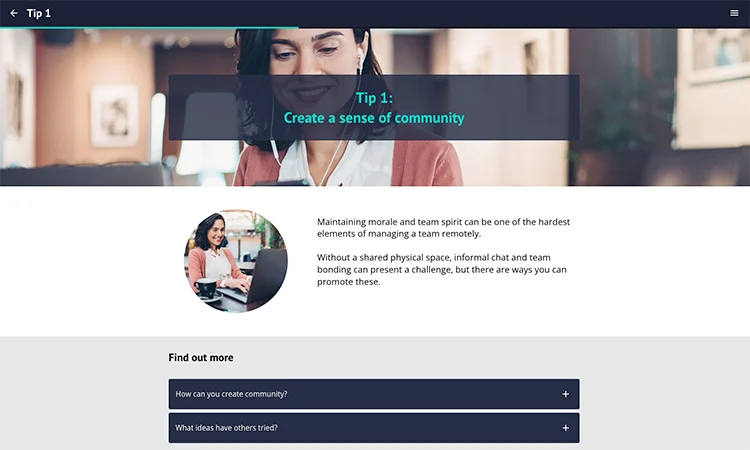
If you want to implement this technique, we have some of the best microlearning examples to help you.
2. Branching scenario
A branching scenario places learners firmly in the driving seat. Depending on their choices at decision points, they’ll navigate unique paths through the content. This ‘choose your own adventure’ style approach is great for showing real-world consequences in a fun and personalized way.
This example of workplace bullying is a prime example of how branching boosts elearning engagement while allowing mistakes to be made in a safe learning environment.
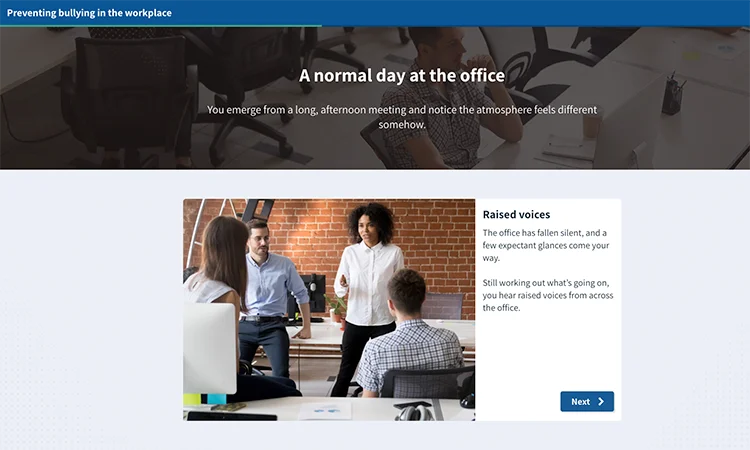
3. One-pager
Opting for a single-scrolling page structure creates an ultra-swift learning journey, delivering essential information to learners with no mucking around.
This one-pager on replenishing stock, for instance, is action-focused. Broken down into steps and checklists, its purpose is crystal clear. Multimedia elements, interactivity, and clever navigation features are the icing on the cake.
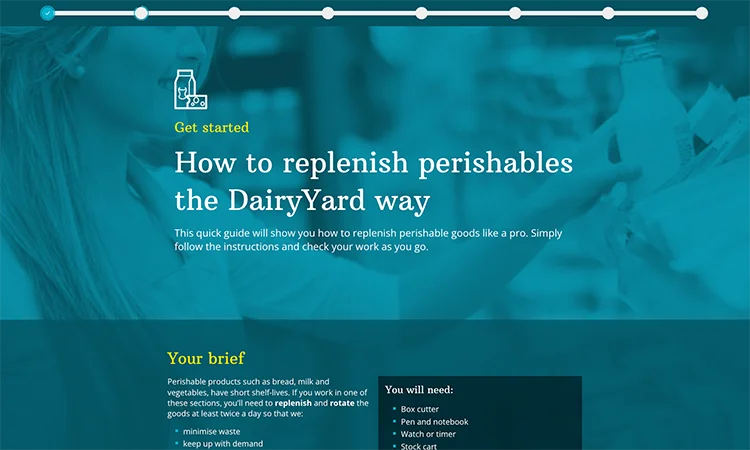
4. Gamified quiz
Adding gameplay elements to your elearning doesn’t need to be complicated. Simply jazz up a standalone knowledge check with features like points, badges, and timers to create a gamified quiz. The outcome? A supercharged elearning experience that’s way more exciting than just clicking ‘next’.
‘Rookie or Rockstar?’ That’s the burning question in this quiz that uses three rounds of gamified questions to put learners’ product knowledge to the test.
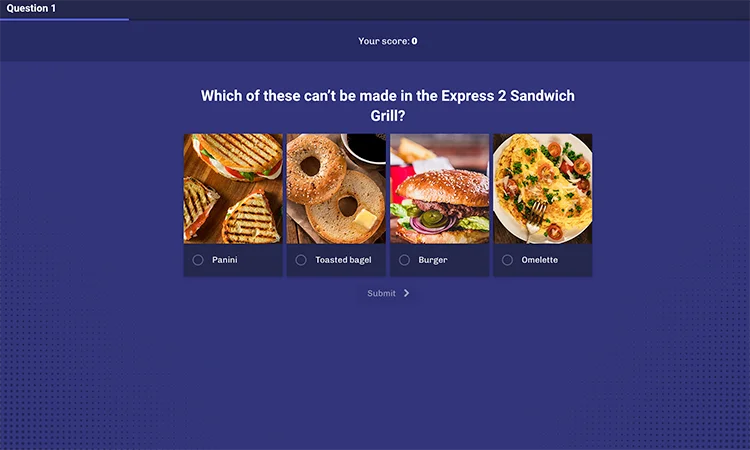
Designing an engaging user experience
Picture this. You’ve poured your heart into creating an amazing eelarning solution. The test group loves it and even your stakeholders are thrilled.
Fast forward to launch day. You open your inbox, expecting virtual high-fives, but instead, it’s flooded with emails.
As it turns out, the elearning doesn’t work on your learners’ default browser.
Lesson learned. No matter how outstanding the learning designer is, if the user experience isn’t on point, engagement in elearning takes a nosedive.
Fear not. Read on for some foolproof tips for smooth sailing every time.
Remove technological barriers
It might seem like a no-brainer, but can your learners actually get online and engage with that awesome content you’ve whipped up? Consider access to devices, internet connection, audio output, and even confidence in navigating the digital world.
Tackle any tech issues pronto or you’ll fall at the first hurdle.
Make learning available on any device
Are your learners using smartphones, tablets, laptops or PCs? If your online content works seamlessly across all devices, it’s no sweat. However, crafting a consistent learning experience regardless of screen size can be challenging.
The great news is tools like Elucidat output responsive elearning as standard. That means the layout automatically reconfigures to best fit the device it’s being viewed on.
Test, test, test!
A sloppy learning experience will have online learners mentally checking out before they even reach the welcome screen. So test all elearning thoroughly on target browsers and devices.
Pay close attention to the quality of writing, visuals, and videos. Is everything consistent? Does it look appealing? Is it all running smoothly? Make your tweaks and retest.
Improve accessibility
Everyone deserves a great learning experience, whether they have a disability or not. That’s why accessibility is crucial.
Don’t treat it as an afterthought. Do your research (WCAG is a great starting point) and build accessibility into your content from the get-go.
Here are three quick wins:
- Include transcripts and alt text for any non-decorative images, video and audio.
- Use a high colour contrast between text and background to enhance readability.
- Beware of interactions that don’t work with keyboard navigation and stick with fully accessible components instead.
Maximize engagement with measurement and iteration
You’ve designed a bunch of engaging content and it’s finally been launched. Time to relax, right?
Wrong.
Elearning engagement isn’t a one-and-done thing. What works today may not work tomorrow. Read on to learn how iteration can keep things fresh.
Measure elearning engagement
You might believe your content is engaging, but what do your learners think? It’s time to get the facts.
There are two primary ways to measure elearning engagement:
- Get their feedback
Create a simple survey to gauge learner engagement with your content. You could integrate this directly into your elearning. To beat bias, use a few questions that ask a similar thing differently. And give learners the chance to suggest improvements.
- Check out the stats
Numbers don’t lie. Are learners completing their elearning? Are they performing well on assessments? Are they voluntarily accessing content? Piece together the data for an objective picture of how your learning is stacking up.
Continue to refresh content
Whether engagement is lagging, or you’re just ready to take your design to the next level, it’s never a bad time to make changes.
Here are some foolproof ways to use iteration to stay at the top of your game:
Action their feedback
Don’t let that valuable feedback gather dust. Start making tweaks to elearning based on what your learners are saying. Feeling a bit lost? Round up a focus group and pick their brains for more insights.
Keep content relevant
Set a regular reminder to give your live elearning once over and check it’s still up to date. At work, things can change fast, so keep your content current to stop inaccuracies from creeping in.
Update date-based information
Nothing ages elearning quicker than outdated examples and ancient stats. Spend a few minutes with Google, and give your content a modern makeover. It’s a small effort that pays dividends in keeping things fresh.
Summary
Want your content creation efforts to pay off? For successful learning outcomes, elearning engagement has to be front and centre.
The good news? It’s not rocket science. Here’s your checklist for crafting content that will have learners hanging on your every word:
- Speak their language: Keep it short, sweet, and relevant. Make sure your elearning is easy to access and digest.
- Design for engagement: Make your online content interactive, actionable, and immersive. Think snappy messaging, meaningful activities, and relevant multimedia material.
- Optimize your format: Whether it’s quick-hit microlearning or a fun-filled quiz, use the right content type to connect with your audience.
- Smooth out the bumps: Get rid of anything that’s getting in the ways to increase engagement and a seamless user experience.
- Stay fresh: Keep a close eye on engagement levels and be ready to shake things up to keep your content feeling new and exciting.
Create engaging elearning with Elucidat
Ready to hit the ground running? Check out Elucidat for a tool that’s tailor-made to create content that checks every elearning engagement box.
Elucidat’s guided workflows and ready-made templates make it easy for anyone to produce engaging online learning at speed. Whether you’re new to elearning or a seasoned author, Elucidat has got you covered.
Want to give it a try? Schedule a demo today and snag a free trial too.

